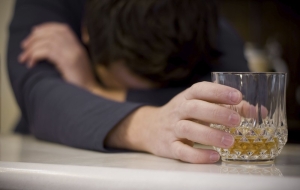Study Finds Lesbian and Gay Teens More Likely to Binge Drink
June 02, 2014 / by Eric Lindberg- Research
Adolescence is an innately tumultuous period during which teenagers begin to form unique identities and transition from childhood to adulthood.
That transition can be particularly difficult for young girls and boys who identify as sexual minorities—lesbian, gay, or bisexual (LGB). They may experience stressors that place them at high risk of engaging in negative behaviors such as heavy alcohol use, an issue explored in a recent study by Jeremy Goldbach, an assistant professor with the USC School of Social Work.
“We wanted to understand whether stress that is unique to being gay, like having homophobic experiences such as bullying, lack of family support, internalized feelings of shame and homophobia, and a lack of peer support networks, was associated with binge drinking,” he said.
Goldbach worked alongside Sheree Schrager, director of research in the Division of Hospital Medicine at Children’s Hospital Los Angeles, and Ian Holloway, a former doctoral student in social work at USC and now an assistant professor with the Department of Social Welfare at UCLA. Using data from a national survey of more than 1,200 LGB adolescents between the ages of 12 and 17, the researchers examined links among sources of stress, psychological distress, and binge drinking.
Results suggest that stress factors experienced by LGB youths, including internalized homophobia and victimization, are associated with patterns of heavy drinking. Goldbach also noted their level of outness, or the extent to which their sexual orientation is known to family members, friends, coworkers, and others, also influences their alcohol use.
“It appears to be a complicated set of relationships,” he said. “Youths who were out to more people reported lower rates of internalized homophobia, which was associated with less binge drinking. We assume that this means being more comfortable internally about your sexual orientation also allows you to come out to more people. At the same time, however, higher levels of outness were directly related to higher binge drinking.”
It may be difficult for teens to strike a balance between revealing their sexual orientation and forming an identity while avoiding exposure to bullying and potentially negative aspects of socialization in the gay community, including prevalent alcohol use.
Goldbach said he observed a similar dynamic at play in a study led by USC doctoral student Jeremy Gibbs that involved LBG individuals living in households characterized as religious and antigay.
“In this analysis, we found that if youths leave their antigay religion, they report less internalized homophobia, which indirectly reduces their suicide risk indirectly,” he said. “However, leaving their religion was also directly associated with an increase in suicide risk.”
“As you are pushing forward, you are also experiencing this undertow that is pulling you back,” Goldbach said.
Warning signs
Exploring issues such as alcohol use among sexual minority adolescents is critical, Goldbach said, because binge drinking can be an early indicator of future problems such as addiction, depression, anxiety, suicide risk, and use of other addictive substances.
A recent analysis of 18 studies showed that sexual minority youths are between two to five times more likely to use drugs and alcohol than heterosexual teens. They are also more likely to start drinking at a younger age, engage in heavy drinking, and make risky decisions regarding sex that can lead to HIV infection or pregnancy.
However, national funding to examine these issues has been scarce, Goldbach said, noting that less than half a percent of all funding from the National Institutes of Health is dedicated to research on sexual minorities.
“Within that half a percent, only 18 percent went to anything outside of HIV risk among young men,” he said. “Looking at adolescence, a critical identity formation period, is important. What happens when you are 14, 15, or 16 has the potential to really change your entire life trajectory.”
Goldbach and his colleagues received support from the James H. Zumberge Research and Innovation Fund at USC to pursue this line of research. He plans to continue examining stress among adolescents who identify as sexual minorities, including efforts to develop a new measurement tool to assess sources of stress in domains such as family and school life.
To reference the work of our faculty online, we ask that you directly quote their work where possible and attribute it to "FACULTY NAME, a professor in the USC Suzanne Dworak-Peck School of Social Work” (LINK: https://dworakpeck.usc.edu)
